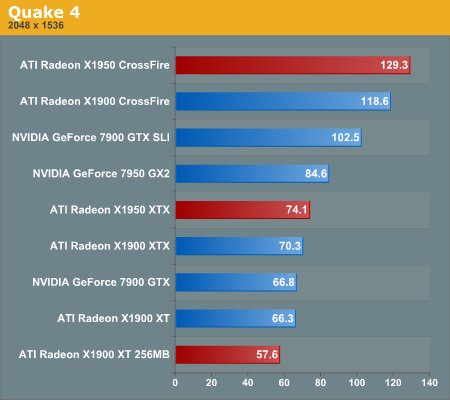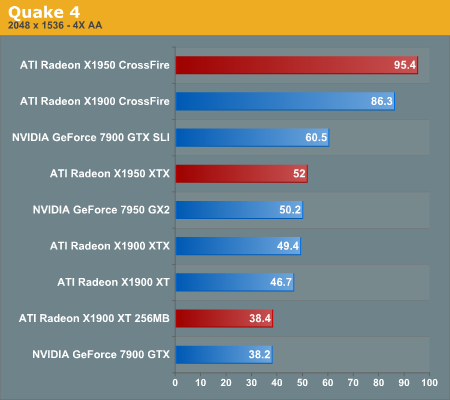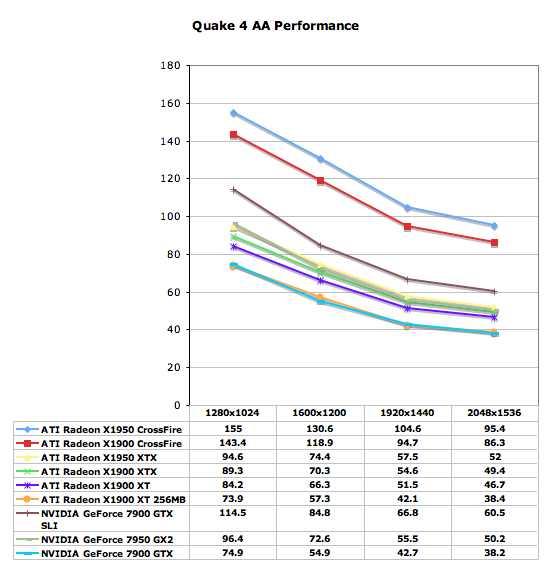ATI's New High End and Mid Range: Radeon X1950 XTX & X1900 XT 256MB
by Derek Wilson on August 23, 2006 9:52 AM EST- Posted in
- GPUs
Quake 4 Performance
There has always been a lot of debate in the community surrounding pure timedemo benchmarking. We have opted to stick with the timedemo test rather than the nettimedemo option for benchmarking Quake 4. To be clear, this means our test results focus mostly on the capability of each graphics card to render frames generated by Quake 4. The frame rates we see here don't directly translate into what one would experience during game play.
Additionally, Quake 4 limits frame rate to 60 fps during gameplay whether or not VSync is enabled. Performance characteristics of a timedemo do not reflect actual gameplay. So why do we do them? Because the questions we are trying to answer have only to do with the graphics subsystem. We want to know what graphics card is better at rendering Quake 4 frames. Any graphics card that does better at rendering Quake 4 frames will play Quake 4 better than other slower cards. While that doesn't mean the end user will see higher performance in the game, it does mean that the potential for seeing more performance is there, for instance if the user upgrades a CPU before the next graphics card upgrade.
Timedemos do walk a fine line between synthetic benchmarks and real world benchmarks. While we tend to favor real world data here at AnandTech, this type of benchmark is very capable of using a real world data set to test the maximum capabilities of the graphics cards under its particular work load without bottlenecking at other points in the system. To be sure, even timedemos can see memory and CPU bottlenecks, as data must be transfered to the graphics card some how. But this impact is much lower than the impact of running AI, physics, script management, I/O, and other game code at the same time.
What this means to the end user is that in-game performance will almost always be lower than timedemo performance. It also means that graphics cards that do slightly better than other graphics cards will not always show a tangible performance increase on an end user's system. As long as we keep these things in mind, we can make informed conclusions based on the data we collect.
Our benchmark consists of the first few minutes of the first level. This includes both inside and outdoor sections, with the initial few fire fights. We test the game with Ultra Quality settings, and we enable all the advanced graphics options except for VSync and antialiasing. Anisotropic filtering is manually set to 8x. Id does a pretty good job of keeping framerate very consistent; in-game framerates of 25 are acceptable. While we don't have the ability to make a direct mapping to what that means in the timedemo test, our experience indicates that a timedemo fps of about 35 translates into an enjoyable experience on our system. This will certainly vary on other systems, so take it with a grain of salt. But the important thing to remember is that this is more of a test of relative performance of graphics cards when it comes to rendering Quake 4 frames -- it doesn't directly translate to Quake 4 experience.

The Doom 3 engine was once NVIDIA's stomping grounds, but Quake 4 performance is now dominated by ATI's Radeon X1900 and X1950 series. The X1950 CrossFire manages a 26% performance advantage over the GeForce 7900 GTX SLI, while the X1900 CF setup pulls ahead by just under 16%.
Among single cards, the X1950 XTX manages about an 11% performance advantage over the 7900 GTX, meaning that CrossFire actually scales much better than SLI in Quake 4 for some reason. The new 256MB X1900 XT is outperformed by its 512MB sibling by a decent 16%. Honestly we were not expecting to see such big differences, especially with AA disabled, between the 256MB and 512MB cards. It's good to see that games are actually using all of this framebuffer being thrown at them.


With AA enabled, ATI does even better, with the X1950 CrossFire outperforming the 7900 GTX SLI by over 57%. ATI has done a lot of work on its OpenGL performance lately and we're currently investigating to see if that's the cause for such a stellar showing in Quake 4 here today.











74 Comments
View All Comments
Ecmaster76 - Wednesday, August 23, 2006 - link
Is it a GDDR3 or a DDR2 product?If the former, any chance it will crossfire with x1600 xt? Oficially I mean (methinks a bios flash might work, though x1650 is maybe a 80nm part)
coldpower27 - Wednesday, August 23, 2006 - link
No I don't think that would work.an X1650 Pro has 600/1400 Speeds so 100% sure is GDDR3, DDR2 doesn't exisit at such high clockspeed.
Genx87 - Wednesday, August 23, 2006 - link
Some of the other reviews had this x1950XT beating the GX2 almost every time, sometimes by a wide margin.I still cant get over the power\transistor\die size to performance advantage Nvidia has over ATI right now.
PrinceGaz - Wednesday, August 23, 2006 - link
Interesting. The first review I read was at where the X1950XTX beat or equalled the 7950GX2 every time, then here the reverse is true. I think I'll have to read more reviews to decide what is going on (it certainly isn't CPU limitations). Maybe 's focus on optimum quality settings rather than raw framerate is the reason they favoured ATI, and another is the clear fact that when it came to minimum framerates instead of average framerates ( posted both for all tests) the X1950XTX was especially good.In other words the 7950GX2 posted great average numbers, but the X1950XTX was playable at higher quality settings because the minimum framerate didn't drop so low. Hopefully some other sites also include minimum framerates along with graphs to clearly show the cards perform.
I remember a few years ago when ATs graphics card articles included image-quality comparisons and all sorts of other reports about how the cards compared in real-world situations. Now it seems all we get is a report on average framerate with a short comment that basically says "higher is better". Derek- I strongly suggest you look at how test cards and the informative and useful comments that accompany each graph. There may only have been three cards in their comparison but it gave a much better idea of how the cards compare to each other.
Anyway I'll not be getting any of these cards. My 6800GT has plenty of performance for now so I'll wait until Vista SP1 and the second-generation of DX10 cards which hopfully won't require a 1KW PSU :)
PrinceGaz - Wednesday, August 23, 2006 - link
It seems the comments system here uses the brackets in HardOCP's abbreviation as some sort of marker. Apologies for making the rest of the text invisible, please amend my comment appropriately. I was talking about HardOCP by the way, when I said they use minimum framerates and optimum quality settings for each card.JarredWalton - Wednesday, August 23, 2006 - link
Don't use {H} in the comments, please. Just like {B} turns on bold, {H} turns on highlighting (white text).
JarredWalton - Wednesday, August 23, 2006 - link
Ah, seems you figured that out already. ;) I need to see if we can disable that feature....haris - Wednesday, August 23, 2006 - link
Actually if you look at all of the reviews a bit more closely the sites the scores depend on which processor is being used for the test. It appears that nVidia cards tend to run better on Conroes(probably just means the games are slightly less cpu bottlenecked at the resolutions being tested) while ATi tends to run better on AMD systems(or when the cpu is slowing things down) Of course that is IIRC from the 5 reviews I skimmed through today.coldpower27 - Wednesday, August 23, 2006 - link
No just no X1950 XTX alone is not more powerful then the 7950GX2. Only in ATI favourable scenarios or where SLI flat out doesn't work will this occur.UNESC0 - Wednesday, August 23, 2006 - link
you might want to run dual monitors...